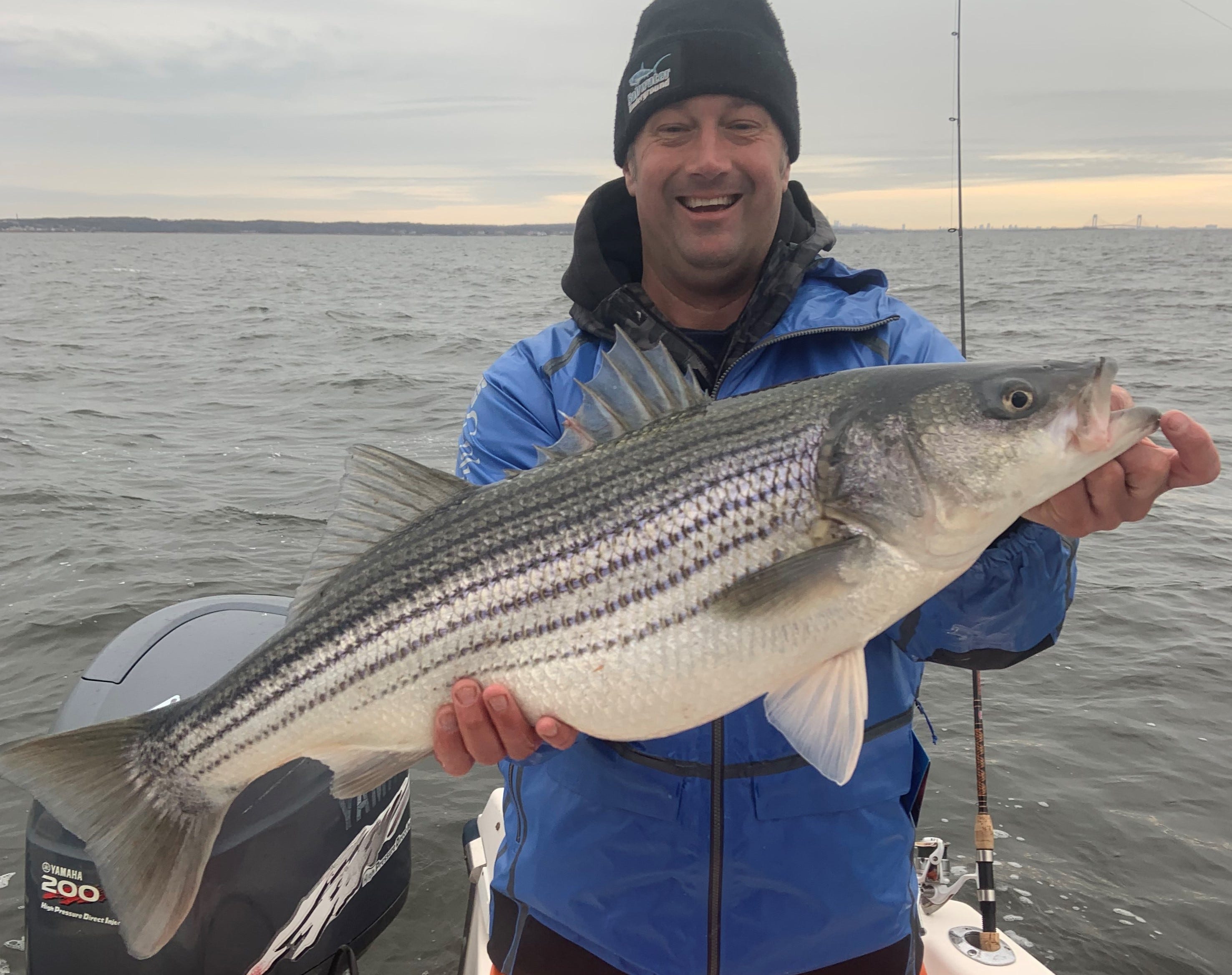- May 4, 2023
Spring Striped Bass Fishing from New Jersey Bays
The Spring striped bass run is underway. Target Jersey’s bays for outstanding spring fishing action. Learn the best baits and approaches for large bays and for smaller bays.


One of the most anticipated migrations of spring is the striped bass run along the Eastern Seaboard. Millions of stripers push up the coastline from Virginia to Maine, entering the Chesapeake Bay, Delaware River, Hudson River and resident minor tributary systems to spawn out and procreate the next generation of bass.
From May through June, striper fishing can be at its finest in New Jersey. Days of playing catch-and-release with more than 50 fish in a four-hour trip are common throughout the small estuarine bays and harbors such as Barnegat Bay, Great Bay and Great Egg Harbor as well as the larger waters of Delaware Bay and Raritan Bay.
For most anglers, the most exciting way to target stripers is with artificial lures, which elicit bone-jarring strikes, followed by brutal battles. Here are a few tricks and tactics to dial you in on the best spring striped bass action.
Big Bay Fishing


Jersey’s two largest bay systems – Raritan Bay and the Delaware Bay – are located at the northern tip and southern tip of the state. The bays are conduits for spawning migratory bass to enter the Hudson River and Delaware rivers, respectively, and provide rod-bending action throughout May and June. While many boating anglers opt for chunking or live-lining bunker on circle hooks, the real excitement occurs when swimming plugs and poppers are thrown to raise feeding fish.
Be on the lookout for visual cues, such as birds diving into the water on bait, bunker schools finning on the surface, and the obvious crashes and splashes of bass exploding on bait.
The idea is to create enough surface commotion to attract the fish away from a bait school to come attack what seems to be a fleeing bunker bait. Top lure options include the Cotton Cordell 7-inch Pencil Popper C67, Rebel Pop-R P71 and Creek Chub Knuckle-Head. When you find fish feeding aggressively on the surface, toss the popper to the outskirts of the school. The key is to slowly pop the lure, and not bring it in fast. Bass will pursue a lure and hit it once, twice, maybe three times before they commit, so a slow pop, rest, pop technique works best. Bass tend to hit on the pause right before you begin to make the next pull. Don’t be surprised when a 30- to 40-pound bass crashes on the popper!
Many times, stripers won’t come quite to the top to hit a popper. That’s when subsurface plugs dial ‘em in. The Bomber Jointed Long A is a perfect imitation for a big bunker bait. Cast to the outskirts of the bait school and simply reel the bait back at a moderate pace. The Bomber Jointed Long A acts like an injured bunker, with its undulating swagger, which bass cannot resist. If they aren’t committed to the Jointed Long A, a 16A Long A offers the same profile but is less erratic because of the solid body construction.
If fish are marking deeper – in 15 to 30 feet of water – switch out your poppers for large soft-plastic baits. Paddletails work wonders on striped bass. The 4 1/2-inch YUM Scottsboro Swimbait imitates a bunker bait with precision as its paddletail calls bass in for a strike. Drop the bait to the bottom and proceed to reel it up slowly, sporadically jigging it in 1- to 2-foot pulls so it surges forward then flutters back down. Hits usually come on the drop.
Small Bay Tactics


In contrast to the wide expanses of big bay fishing and searching for massive schools of monster bass, backwater bay systems offer a precision-based arena, with smaller, 5- to 15-pound-class fish. Fishing small bays involves more honed-in structure fishing, navigating back creeks, side channels and channel edges, and working sodbanks, piers and bridge pilings. Instead of big bunker baits being the predominant forage, small baits such as spearing and bay anchovies are prevalent. Smaller, thin, soft baits are supreme in this environment. As full flood tides envelop the sodbanks, the outgoing waters suck all the crabs, worms, and baitfish out of the flats and push them into the channels where bass await.
Stripers hang up close to the sodbanks and use them as ambush points to surprise baitfish. A sodbank can drop down to 10 feet or more, like an underwater cliffside, and soft baits worked through the water column there will tempt stripers sitting in the depths.
Rig soft baits like the YUM Money Minnow and Break-N-Shad on a ½-ounce lead jighead to fish along the sodbanks. Casting right to the edge of the bank, allow the bait to sink near the bottom, and reel back slowly and steadily, adding a twitch or two every two to three seconds. For fishing structures, such as bridge stanchions and pier pilings, drifts need to be stationed away to avoid spooking the fish, with casts placed deftly next to the structure and allowed to sink into the feeding column 5 to 10 feet below.
When you enter the deeper back bay channels of 10 to 25 feet, soft baits still work but it’s more of a vertical approach with jigging techniques. Anglers will set a drift through channels, dropping down a YUM Money Minnow or a YUM Scottsboro paddletail. The approach with the small soft baits is to slightly twitch the bait in a one-two cadence every two seconds or so.
The key to striper success is to understand the environment you are fishing, whether it is a big bay expanse or a contained backwater locale. Gear up accordingly to match the baitfish present in the arena and mimic the forage species in its behavior and profile. Lurenet’s options can help you claim the bass of your dreams.



